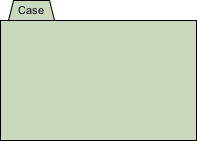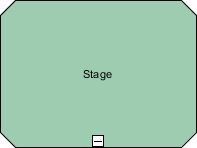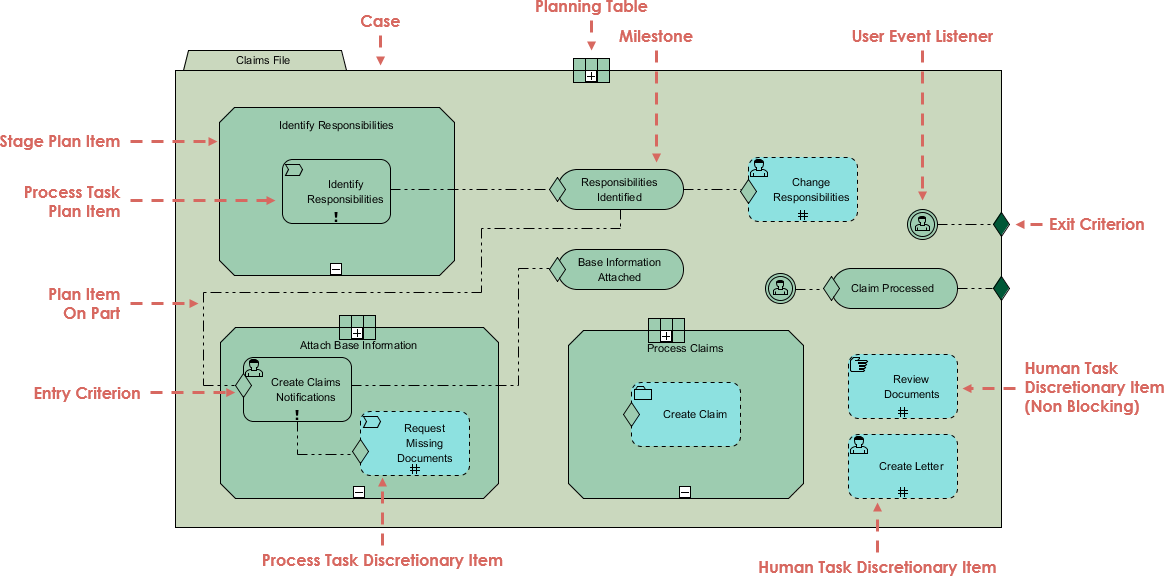| Case Plan Model |
Graphical Notation (Discretionary task on right) |
Discretionary Human Task
- The complete behavior model of a Case is captured in a Case Plan Model.
- A Case Plan Model is depicted using a "Folder" shape that consists of a rectangle with an upper left smaller rectangle attached to it.
- The name of the Case can be enclosed into the upper left rectangle.
|

|
Stage
- Stages are Plan Fragments that can be tracked.
- Stages maybe considered "episodes" of a Case. They can be regarded as sub-cases (cf. sub-processes in BPMN)
- A Stage is depicted by a rectangle shape with angled corners and a marker in the form of a "+" sign in a small box at its bottom center.
- When the Stage is expanded it is depicted by a rectangle shape with angled corners and a marker in the form of a "-" sign in a small box at its bottom center.
|
 |
Task
- A Task is a unit of work. There are three types of Tasks.
- A Task is depicted by a rectangle shape with rounded corners.
- A discretionary Task is depicted by a rectangle shape with dashed lines and rounded corners.
|
 |
Non-blocking Human Task
It is depicted by a rectangle with rounded corners and a "Hand" symbol in the upper left corner.
|
 |
Blocking Human Task
It is depicted by a rectangle with rounded corners and a "User" symbol in the upper left corner.
|
 |
Case Task
A Case Task is depicted by rectangle shape with rounded corners with a "Folder" symbol in the upper left corner and they can be used to call another Case
|
 |
Milestone
- A Milestone is a Plan Item Definition that represents an achievable target, defined to enable evaluation of progress of the Case.
- No work is directly associated with a Milestone, but completion of set of tasks or the availability of key deliverables (information in the Case File) typically leads to achieving a Milestone.
- A Milestone is depicted by a rectangle shape with half-rounded ends.
- A Milestone may have zero or more entry criteria, which define, when a milestone is reached
|
 |
Event Listener
- An event is something that "happens" during the course of a Case. CMMN predefines many events, and their causes:
- Anything that can happen to information in the Case File.
- Anything that can happen to Stages, Tasks and Milestones.
- Event Listeners are used to model events that do not happen to plan items.
- An Event Listener is depicted by a double line circle shape
- Event Listeners are specialized to
- An Event Listener is depicted by a double line circle shape with an open center so that markers can be placed within it to indicate variations of an Event Listener.
- The circle MUST be drawn with a double line.
|
 |
Case File Item
A Case File Item is depicted by a "Document" shape that consists of a rectangle with a broken upper right corner.
|
 |
Process Task
A Process Task is depicted by a rectangle shape with rounded corners with a "Chevron" symbol in the upper left corner and they can be used in the Case to call a Business Process
|
 |
Decision Task
- A Decision Task may be discretionary (i.e., used as Discretionary Item contained in a Planning Table).
- A discretionary Decision Task is depicted by a dash lined rectangle with rounded corners with a Decision Table symbol in the upper left corner.
|
 |
Plan Fragment
- A Plan Fragment is a container of Plan Items and the Sentries
- A Plan Fragment is depicted by a rectangle shape with dashed lines and softly rounded corners and a marker in the form of a "+" sign in a small box at its bottom center
- When the Plan Fragment is expanded it has a marker in the form of a "-" sign in a small box at its bottom center.
- When a Plan Fragment is expanded, elements contained in it become visible
|
 |
Planning Tables
- Users (Case workers) are said to "plan" (at run-time), when they select Discretionary Items
- A Planning Table defines the scope of planning.
- Planning Tables can be assigned to a Stage or a Human Task.
- Stages: The Planning Table can be used to plan instances of Tasks and Stages into that Stage instance.
- Human Tasks: The Planning Table can be used to plan instances of Tasks and Stages into the Stage that contains the Human Task.
- A Planning Table is depicted by a "Table" shape.
- A Planning Table can have several Table Items (i.e. Discretionary Items). Planning Table and Table Items can have applicability rules.
|
 |
Sentry
- Plan Items may have associated Sentries.
- When a Sentry is used as an entry criterion it is depicted by a shallow "Diamond" shape.
|
N/A |
Sentry for Entry
When a Sentry is used as an exit criterion it is depicted by a solid "Diamond" shape.
|
 |
Sentry for Exit
When a Sentry is used as an exit criterion it is depicted by a solid "Diamond" shape.
|
 |
Manual Activation Decorator
- Under which conditions will Tasks and Stages, once enabled, start manually or automatically
|
 |
Required Decorator
- Under which conditions will Tasks, Stages and Milestones be "required" to complete or terminate before their containing Stage can complete.
|
 |
Repetition Decorator
- Under which conditions will Tasks, Stages and Milestones need to be repeated.
|
 |
Links
- Certain dependencies between elements that are shown inside expanded Stages or Plan Fragments are depicted using links.
- The shape of the connector object is a dash-dot-dot line.
- The connector MUST not have arrowheads.
|
 |



















